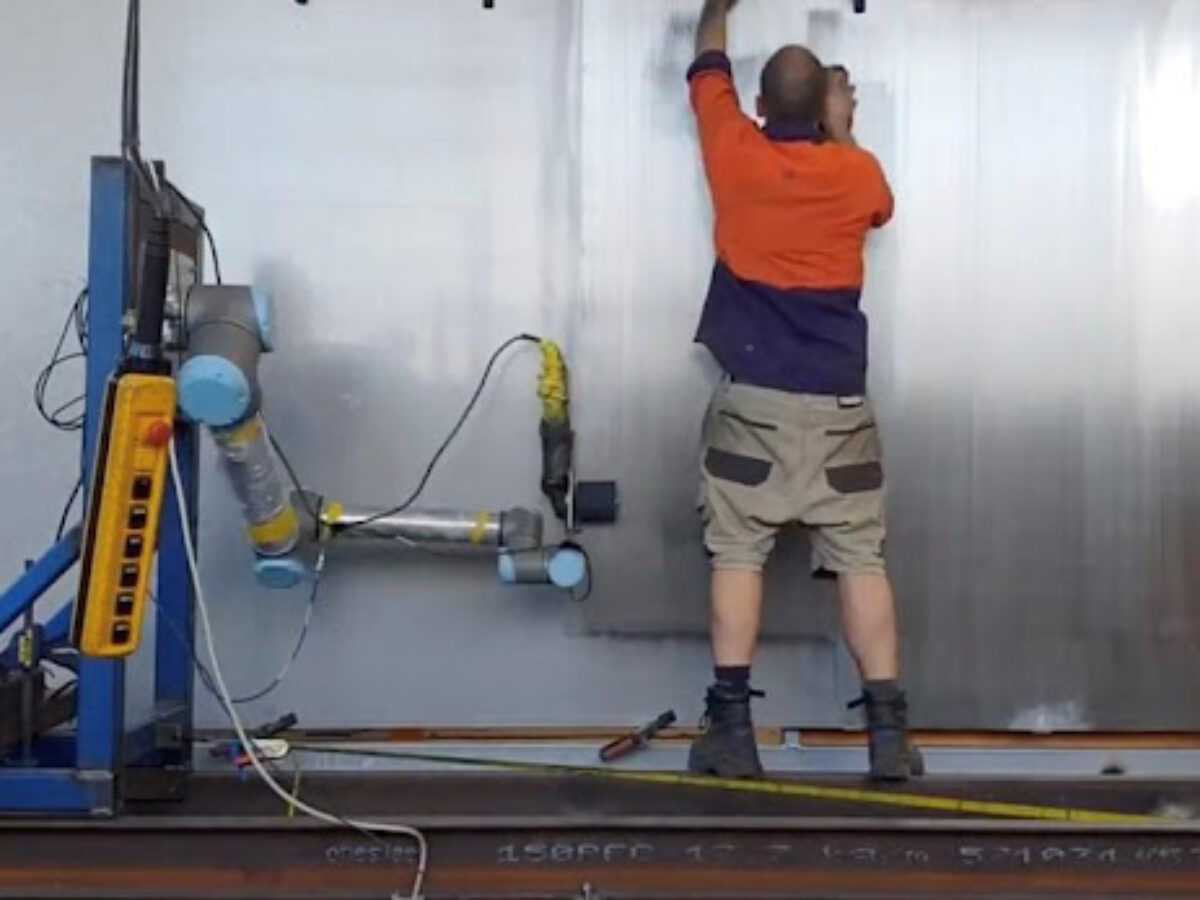Leadership in factory automation — exploring collaborative robotics

Today Leadership in factory automation looks at the potential of collaborative robots as a low-cost, more flexible and safer alternative to traditional factory robots. By Professor Jonathan Roberts.
Manufacturing in Australia is dominated by small to medium enterprises (SMEs). Many of these businesses are not in a position to adopt mass production manufacturing methods due to the small volumes and large variety of the things they produce. Low-volume, high variability of product is considered a strength of these businesses as long as they can remain cost competitive.
A combination of labour shortages, constantly improving health and safety considerations and the need for increasing efficiency of the manufacturing process are driving some of these SMEs to consider new ways of adopting robotics.
It seems what these SMEs are hoping for is a robot that complements the experience and expertise of their staff, can be used for a variety of jobs, is probably portable within their factories and can be easily reconfigured and set up by the existing staff in their businesses. And of course such a robot needs to be affordable and safe around people. Decades ago this was a pipedream, but things have moved on, and there are some examples of businesses adopting so-called collaborative robots (or ‘cobots’) in this way.
One of the first robots specifically designed and commercially produced to tackle this challenge was the Baxter Robot by US company Rethink Robotics. It was designed to be affordable, safe around people and easy to program – exactly what SMEs now need. The first Baxter was sold in 2011 but it was not a major commercial success. The company developed a follow up robot called Sawyer but it too has not been widely adopted at this time. These types of robots have been referred to as Collaborative Robots and there are now dozens of companies selling similar robots.
Cobots offer a low-cost, more flexible and safer alternative to the robots seen more often in traditional manufacturing settings. They do not need safety cages to keep people away and require less floor space and less infrastructure to operate. A cobot’s light payload capacity means they can be introduced in areas where previously a robot would not have been possible. One example is the food industry where they are now commonly used for picking and placing items into packaging alongside the human worker.
Despite all these benefits, we are still not seeing wide adoption where such robots would need to be moved or significantly reconfigured during a production cycle. The Australian Cobotics Centre has been created to help overcome some of the barriers. Through its five research programs, the Centre hopes to address the technological, design and human factors that are barriers to adoption.
Specifically these programs will address:
- How the implementation of collaborative robotics will impact the workforce including future skills and training needs; design and safety of jobs of the future; managing workplace readiness; and greater workforce diversity and longevity.
- How collaborative robots can mimic humans in acquiring perception and awareness, learning, adaptation and manipulation skills. The work will develop the robot perception, motion planning and learning theory, and algorithms for safe, reliable, adaptive and comfortable human-robot/robot-robot adaptation for tasks such as welding, assembly, inspection, material handling and polishing. Such cobots can also enable workers with certain sensory or motoring deficiencies to complete manufacturing tasks.
- How to interact safely with an industrial robot across the whole production cycle, with minimal need for training. This includes how humans are made aware of the movement and intentions of robotic systems (mutual awareness & robotic intention visualisation), how to build toolkits for the rapid prototyping of collaborative robotic solutions, and how to leverage multimodal interaction, including Augmented Reality and Virtual Reality, with robotic systems
- How to embed holistic design as a critical factor in creating seamless integration of humans and machines working together. It is important to consider their relationship to humans in work practices, places, and systems. Key design factors also include the products to be manufactured by the collaborative robot, the overarching manufacturing process, and the space requirements that support human-robot interaction and collaboration
- How to create a complete digital thread across the product lifecycle that is vital for high value-add manufactured products subject to regulatory constraints and oversight (e.g. medical devices, defence and aviation). The research aims to develop tools for the specification, capturing, monitoring and evaluation of such a digital thread in human-robot and robot-human collaboration scenarios
Picture: supplied
Professor Jonathan Roberts is Director of the Australian Cobotics Centre, which commenced on 31st August 2021 and is a federally co-funded research centre in the Australian Research Council’s Industrial Transformation Training Centre scheme. It is a collaboration of researchers from Queensland University of Technology, University of Technology Sydney, Swinburne University of Technology, the Technical University of Dortmund and six industry partners.
@AuManufacturing’s editorial series – Leadership in factory automation – is brought to you with the support of Bosch Australia Manufacturing Solutions, and the Innovative Manufacturing Cooperative Research Centre.


Subscribe to our free @AuManufacturing newsletter here.
Topics Analysis and Commentary
@aumanufacturing Sections
Analysis and Commentary Awards Defence Manufacturing News Podcast Technology Videos






